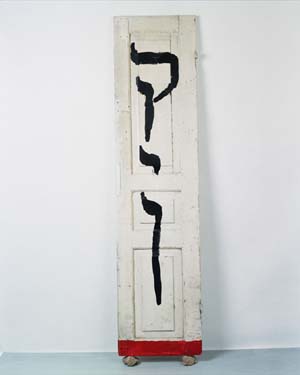These are works whose perception of art relies on experience, on observation of the world, and on the written word; they carry out a dialogue with reality centering on questions pertaining to human nature and man”s place in the world, to a given state of solitude and alienation (with regard to nature and with regard to man himself) and the ability to “touch” the world; questions about the nature of human existence, torn between an inner and an outer world; questions about morality, violence, horror and loss. Keydar counterbalances the preoccupation with the big questions with humor, irony and playfulness. The very hand that strives to guide one to the rudimentary questions of art and life, often seems to undermine itself; while addressing “grave” matters, it treats this preoccupation with humor and scorn, and declares itself insignificant.
The work process is an integral part of the work itself, and the first questions arising from the work pertain to that process: What is the moment of the work’s creation? Where is the line between the door as an indefinite, used, found object, a superfluous, cast-off remnant of the functional world, and its emergence as an art object with a poetic-spiritual value? Perusal of the boundaries of creation is also manifested in its artistic means: the use of the line, stain and form is so accurate and restricted, that it seems as though some of the works are exercises exploring the minimum painterly means required for a work to be deemed a work of art. The door as the opening of the house primarily illustrates the link between interior and exterior, and the artificiality of their differentiation. Referring to the door in the context of the house forces one to think in terms of opening and closing, concealing and revealing. The situation in which the viewer stands on the threshold of a closed door, waiting for it to open and let him in, metaphorizes the given situation of a viewer facing a work of art in an attempt to decipher it and thereby enter other worlds of emotion and thought. In his art Keydar seeks the viewer’s moments of wonder and perplexity.
The use of ready-made and the few, ostensibly incidental line touches invoke the question: “So why is it art?” The works introduce this question not as a provocation, but rather as an honest exploration of the boundaries of the field. The metaphor, however, goes beyond the intra-artistic discussion, allowing for a broad spectrum of interpretations; from a general statement about human existence as standing before a closed door behind which the secrets of life are locked, to allusion to a concrete state of moral obtuseness, as part of which an entire population is confronted with a closed door. Alongside the conceptual exploration there is a constant striving for a world of feelings and associations involving a group of uprooted doors, possibly inviting, possibly turning their backs, doors that oscillate between the desirable and the rejected.
Efrat Livny
Less Reading...
